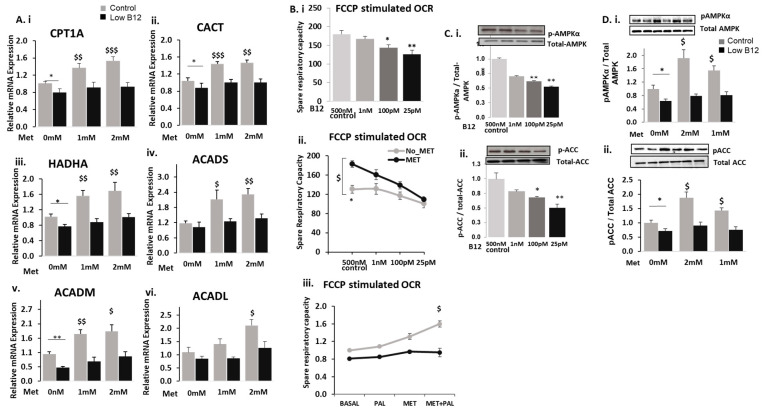Figure 2.
Low B12 impedes metformin action on fatty acid oxidation (FAO) and mitochondrial function via impaired AMPK: The mRNA expression of (A) fatty acid oxidation genes such as CPT1 (i), CACT (ii), HADHA (iii), ACADS (iv), ACADM (v) and ACADL (vi) normalized to 18S rRNA endogenous control (Applied Biosystems, Knutsford, UK). (B) The spare respiratory capacity of hepatocytes in: (i) substrate-rich KHB substrate medium containing glucose (2.5 mM), pyruvate (1 mM), an amino acid (L-Glutamine) (2 mM) and BSA (0.1%) at pH 7.4 under various B12 conditions; (ii) in metformin-treated hepatocytes under various B12 conditions and (iii) in a limited-substrate KHB medium containing only 0.5 mM L-carnitine and 1.25 mM glucose and supplemented with palmitate (200 µM)/BSA (33.3 µM) (basal control) under different B12 conditions. (C) Represents pAMKα (i) and pACC (ii) levels normalized to total AMPK and ACC, respectively. (D) Metformin treatment failed to restore pAMPKα (i) and pACC (ii) levels with low B12. The data is representative of mean ± SEM (n = 6), and * represents significance compared to controls B12 (500 nM) and low B12 (25 pM), $—compared to controls B12 (500 nM) in 1 mM and 2 mM metformin and &—compared to low B12 (25 pM) with 1 mM metformin and 2 mM respectively; * p < 0.05, ** p < 0.01, $ < 0.05, $$ < 0.01, $$$ < 0.001.

